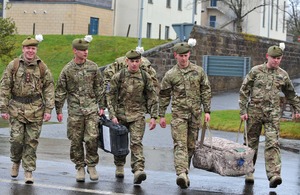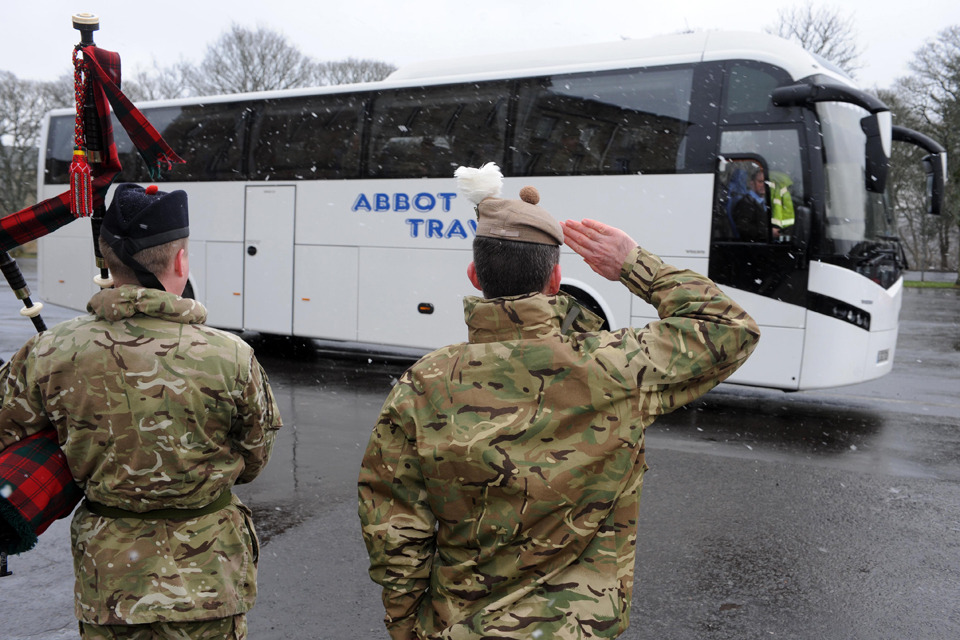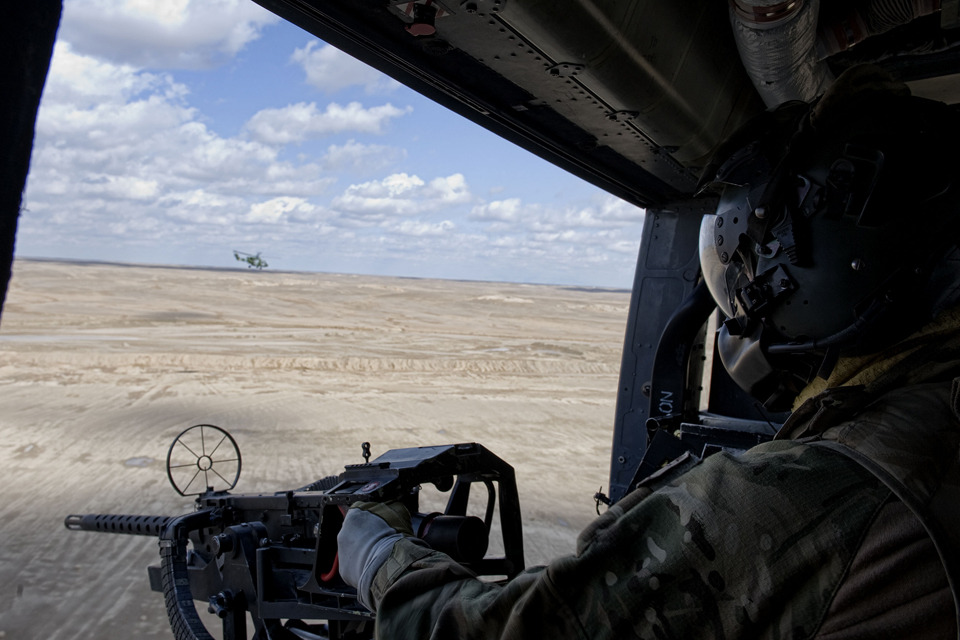Army and Navy units deploy to Afghanistan
Soldiers from 2nd Battalion The Royal Regiment of Scotland are deploying to Afghanistan and 847 Naval Air Squadron is already at work there.

Soldiers from 2nd Battalion The Royal Regiment of Scotland ready for their deployment to Afghanistan [Picture: Mark Owens, Crown copyright]
Around 350 soldiers from 2nd Battalion The Royal Regiment of Scotland (2 SCOTS) are deploying to Afghanistan throughout March 2013 on Operation Herrick 18, and the Royal Navy’s 847 Naval Air Squadron has once again deployed to Afghanistan to perform the critical task of protecting troop movements in and around Helmand province.
The soldiers from 2 SCOTS are deploying as part of Task Force Helmand, commanded by the British Army’s 1st Mechanized Brigade, and will take on a variety of roles, including advising and training the Afghan National Security Forces.
The Commanding Officer of 2 SCOTS, Lieutenant Colonel Robin Lindsay, said:
I am clear that we have a pivotal role at this point in the campaign. The Afghans now have the lead for providing security in most of Afghanistan, so assisting and advising the Afghan Police in their role of providing security for the Afghan people is a very valuable and worthwhile task.
2 SCOTS will be building on the good work of our predecessors and our focus is now on ensuring that the institutions of the Afghan Police are further strengthened through effective training.
The battalion will be advising Afghan police chiefs in Nad ‘Ali, Nahr-e Saraj and Lashkar Gah as well as assisting in the training of new Afghan police officers at the Lashkar Gah Training Centre (LTC), a key factor in securing the future of Afghanistan.

A bagpiper and senior officer salute the departing troops at Glencorse Barracks near Penicuik in Scotland [Picture: Mark Owens, Crown copyright]
Major Jock McGown, Officer Commanding the LTC, said:
The task ahead of us is vital and exhilarating. We are building on a solid foundation laid by 4 Brigade, ensuring that we give institutional depth to police training in Helmand.
From what I have seen things are well-advanced. My team and I are looking forward to helping move things on even further.
The 2 SCOTS’ soldiers have undertaken a busy and often challenging training programme over the last 9 months to ensure that they are ready for their role working with the Afghan Police.
The programme has included cultural training and conflict resolution; understanding and diplomacy will be key to the work of the battalion over the next 6 months.
Their role in Afghanistan means that the traditional structures of platoons and companies have been replaced by district advisor teams and district training teams; a set-up optimised to train and advise the Afghan Police in the best way possible.

A Lynx helicopter releasing flares over Helmand province in Afghanistan [Picture: Corporal Jamie Peters RLC, Crown copyright]
Meanwhile, already in Afghanistan, 847 Naval Air Squadron are flying small and highly agile Lynx helicopters, which are perfectly suited to being ‘eyes in the sky’, protecting the larger RAF Chinook helicopters as they shuttle troops to where they need to be in the area of operations.
Lieutenant James Nottingham, a pilot with the squadron, said:
What the Lynx aircraft can offer is fantastic. They are perfectly suited to protecting our troop moves and they free up the Apache attack helicopters for other tasking.
Even though the Lynx helicopters in Afghanistan belong to the Army, the crews flying and operating them are from the Royal Navy. They are ideally suited to do this and have trained hard for their deployment.
Pilot Lieutenant Alex Lovell-Smith said:
We spent a month training in the desert in California so we were ready to deploy. The climate there is very similar to the winter here in Helmand but the most challenging things to deal with both here and there are the dust landings.
The helicopters, which always travel in pairs, have seen a real change in the pace of operations since the last time the squadron was deployed to Afghanistan.

A Royal Marines aviation crewman manning a heavy machine gun onboard a Lynx helicopter [Picture: Corporal Jamie Peters RLC, Crown copyright]
As the numbers of troops are reduced, air moves are less frequent and reconnaissance flights for future operations are fewer.
In spite of this, the helicopters are still required to be at the ready and are equipped with the latest in military hardware and weaponry, including the formidable .50-calibre machine gun.
Lance Corporal Jordan Schofield, a Royal Marines aviation crewman with the squadron, said:
This weapon is ideal for what we are doing here.
The squadron Operations Officer, Captain Ian Moore, also from the Royal Marines, added:
It’s enough that we are there as a deterrent, but, with a fire rate of 17 rounds per second, everyone we’re working with feels much safer when we are around.
The Lynx helicopters used in Afghanistan look different to the traditional type you may see flying inthe skies around the UK. They have bigger engines to cope with the harsh climate in the Afghan desert.
They are also the same engines that have been fitted to the new Wildcat helicopters, which 847 Naval Air Squadron will start training on when they return home.